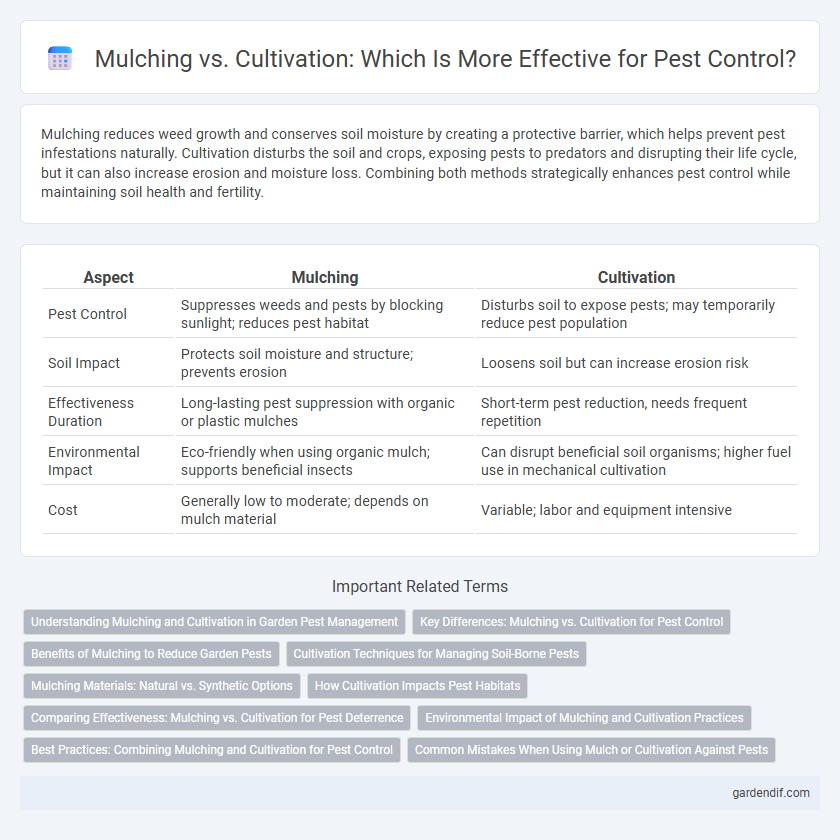
Mulching vs Cultivation Illustration
Mulching reduces weed growth and conserves soil moisture by creating a protective barrier, which helps prevent pest infestations naturally. Cultivation disturbs the soil and crops, exposing pests to predators and disrupting their life cycle, but it can also increase erosion and moisture loss. Combining both methods strategically enhances pest control while maintaining soil health and fertility.
Table of Comparison
| Aspect | Mulching | Cultivation |
|---|---|---|
| Pest Control | Suppresses weeds and pests by blocking sunlight; reduces pest habitat | Disturbs soil to expose pests; may temporarily reduce pest population |
| Soil Impact | Protects soil moisture and structure; prevents erosion | Loosens soil but can increase erosion risk |
| Effectiveness Duration | Long-lasting pest suppression with organic or plastic mulches | Short-term pest reduction, needs frequent repetition |
| Environmental Impact | Eco-friendly when using organic mulch; supports beneficial insects | Can disrupt beneficial soil organisms; higher fuel use in mechanical cultivation |
| Cost | Generally low to moderate; depends on mulch material | Variable; labor and equipment intensive |
Understanding Mulching and Cultivation in Garden Pest Management
Mulching creates a physical barrier that suppresses weed growth and maintains soil moisture, reducing habitat for pests like slugs and root maggots. Cultivation disturbs the soil surface, disrupting pest life cycles by exposing larvae and eggs to predators and environmental stress. Combining mulching and cultivation enhances garden pest management by balancing pest suppression with soil health preservation.
Key Differences: Mulching vs. Cultivation for Pest Control
Mulching creates a physical barrier that suppresses weed growth and retains soil moisture, reducing pest habitats and curbing insect infestations naturally. Cultivation disrupts soil, exposing pests to predators and unfavorable conditions, but may also harm beneficial organisms and increase erosion risk. While mulching emphasizes protective coverage, cultivation relies on soil disturbance to manage pests effectively.
Benefits of Mulching to Reduce Garden Pests
Mulching acts as a natural barrier that limits pest access to plants by covering the soil and disrupting the habitat of harmful insects. Organic mulches, such as straw or wood chips, enhance soil health by retaining moisture and promoting beneficial microbial activity, which suppresses pest populations. This method reduces the need for chemical pesticides, fostering a healthier, more sustainable garden ecosystem.
Cultivation Techniques for Managing Soil-Borne Pests
Cultivation techniques for managing soil-borne pests involve regular soil tilling to disrupt pest life cycles and reduce populations of harmful nematodes, fungi, and insects. Deep plowing exposes pests to predators and environmental stresses, decreasing their survival rates, while shallow cultivation helps control weed hosts that harbor pests. Integrating crop rotation with targeted cultivation enhances soil health and minimizes pest reinfestation, promoting sustainable pest management in agricultural systems.
Mulching Materials: Natural vs. Synthetic Options
Mulching materials play a crucial role in pest management by creating physical barriers that inhibit pest access and improve soil health. Natural mulches such as straw, wood chips, and compost encourage beneficial insect populations and enhance soil microbial activity, while synthetic options like plastic films offer more durable weed suppression but may disrupt soil aeration and harbor pests beneath. Selecting mulching materials depends on the pest species involved, environmental conditions, and long-term sustainability goals of the cultivation system.
How Cultivation Impacts Pest Habitats
Cultivation disrupts pest habitats by breaking up soil and exposing pests to predators, reducing their survival rates. It also disturbs pest eggs and larvae, decreasing population growth and limiting infestations. Unlike mulching, cultivation directly alters the soil environment, making it less favorable for pest development.
Comparing Effectiveness: Mulching vs. Cultivation for Pest Deterrence
Mulching effectively suppresses pests by creating a physical barrier that reduces weed growth and maintains soil moisture, which discourages insect habitat. Cultivation disrupts pest life cycles by physically disturbing the soil, exposing larvae and eggs to predators and environmental conditions. Comparing effectiveness, mulching offers longer-lasting pest deterrence with less labor, while cultivation provides immediate pest population control but may require frequent application.
Environmental Impact of Mulching and Cultivation Practices
Mulching significantly reduces soil erosion and conserves moisture, promoting healthier soil ecosystems and reducing the need for chemical inputs. Cultivation, while beneficial for aerating soil, can increase greenhouse gas emissions and disrupt beneficial soil microbes, leading to potential long-term degradation. Incorporating mulch into pest management strategies supports sustainable agriculture by enhancing soil health and minimizing environmental harm.
Best Practices: Combining Mulching and Cultivation for Pest Control
Combining mulching and cultivation enhances pest control by creating unfavorable conditions for pests while promoting healthy soil. Applying organic mulch such as straw or wood chips suppresses weed growth and moisture retention, reducing habitats for pests, while careful cultivation aerates the soil and disrupts pest life cycles. Integrated use of these methods maximizes pest management efficiency, improves soil fertility, and supports sustainable agricultural practices.
Common Mistakes When Using Mulch or Cultivation Against Pests
Common mistakes when using mulch against pests include applying it too thickly, which can create a moist environment conducive to insect infestations and fungal growth. In cultivation, over-tilling disrupts beneficial soil organisms and can bring dormant pest eggs to the surface, increasing pest populations. Both practices require precise timing and moderation to effectively manage pests without harming the ecosystem.
Mulching vs Cultivation Infographic

 gardendif.com
gardendif.com